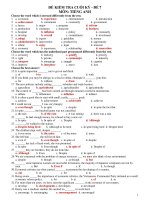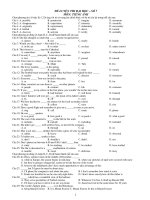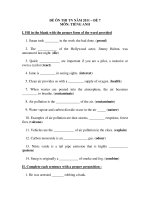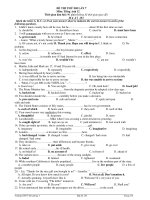UNIT 7 TRAFFIC Tieng anh 7
Bạn đang xem bản rút gọn của tài liệu. Xem và tải ngay bản đầy đủ của tài liệu tại đây (155.62 KB, 5 trang )
<span class='text_page_counter'>(1)</span>GIÁO ÁN DẠY HỌC THEO CHỦ ĐỀ Môn : Tiếng Anh 7 Lớp thực hiện : 7A Giáo viên thực hiện : Vũ Thị Hải Yến Ngày dạy : 09/01/2017 Tiết 1: Period 73:. UNIT 7: TRAFFIC Lesson 1: Getting started: Monday in the playground I.Aims: By the end of the lesson, students can be able to use the lexical items related to the topic "Traffic". Practice reading the dialogue and get to know some means of transport. * Teaching aids: Tape + radio + pictures. II. Presentation: 1.Warm up: Hang man : Ss guess each letter of the word : TRAFFIC Teacher asks : How do you go to school every day? What mean of transport is faster ? What mean is safer ? What mean do you like most ? Why? What can you see on the way to school every day? T says : What about the people in the lesson, How do they go to school or How long it takes them to school every day ? Let's start our lesson today. 2.Vocabulary: traffic jam (n) : sự tắc nghẽn giao thông ship (n) : tàu thủy sail (v) : chèo thuyền get on (v) : lên (xe, tàu) # get off (v) : xuống (xe, tàu) except (pre) : ngoại trừ Checking : RoR 3. Set the scene: Who are the people in the picture? What are they doing ? What are they talking about? Let's listen to their conversation T plays the recording, students listen and practice reading in pairs. a. Ss read the conversation again and then work independently or in pairs to choose the correct answers : Key : 1B 2A 3B 4C T then checks their answers and gives explanation if necessary..
<span class='text_page_counter'>(2)</span> b.Ss work in pairs. T lets them check the answers in pairs or groups , then T gives the keys. If there is time , call some pairs to read the questions and give answers. Key :1. She played with her brother / stayed home 2.It's about 2 kilometers. 3.She usaully goes to school with her dad. 4.Because sometimes there are traffic jams. 5.She goes to school by bike. c. Colloquial expressions: T tells Ss to refer back to the conversation to find the phrases. Ss practice saying them together (T plays the recording again if necessary). Explain the meaning (or give synonyms/Vietnamese equivalent) to the students,then give some examples. hey: to have someone's attention great idea : when you strongly support or agree with something. can't wait: very excited and keen to do something. T asks Ss to role-play the short conversation in pairs before creating their short role-play. More able Ss can try to extend the conversation. 4. Ss work in pairs and write the means of transport under the right pictures. Then T lets Ss read each word correctly. Check and correct their pronunciation. Key : 1 bike/ bicycle 2. bus 3. plane 4. boat 5. ship 6. train 7. motorbike 8. car 5. Ss work individually to do the task, and write their answers in their notebooks. T checks their answers Key : 1. ride a bike 2. drive a car 3. fly by plane 4. sail on / in aboat 5. get on / off a bus/ a train / a bike / a motorbike. -Then Ss make their own sentences with these phrases. Ex: My father taught me how to ride a bike. 6. Game : find someone who never : + walks to school + goes to school by bus + cycles for exercise + takes a train + sails on / in a boat + flies by a plane Let Ss stand up and go round the class to ask everyone the questions: How often do you walk to school/ go to school by bus...? Do you (often) walk to school / go to school by bus...? Ss have to take notes, and then some of them report their result to the class. III. Homework: + Learn by heart vocabulary.
<span class='text_page_counter'>(3)</span> + Do exercises Part 2 + Prepare for A closer look 1 Tiết 2: Period 74:. UNIT 7: TRAFFIC Lesson 2: A closer look 1 --- TT&TT --I.Aims: By the end of the lesson, students can be able to get to know the meaning of road signs, practice pronouncing sounds /e / and /ei/ correctly in isolation and in context. Teaching aids: Tape + radio. II. Presentations: 1. Warm up: Brainstorm - Let Ss give all the road sings they see every day on the way to school, or elsewhere, and all the words they know related to the topic of traffic and transport. Encourage them to say out as many words as possible. 2. Vocabulary: Matching - Ss look at the pictures in 1 and match with the given phrases in 2 1. traffic lights 2. no parking 3. no right turn 4. hospital ahead 5. parking 6. cycle lane 7. school ahead 8. no cycling -T explains the meanings of these road signs in Vietnamese to the students. -Ss practice reading in chorus. -T explains : There are 3 kinds of road signs: + A sign within a red triangle will warn you of something. + A sign with red circles are mostly prohibitive – that means you can't do something.
<span class='text_page_counter'>(4)</span> + signs in blue are usually to give information. 3.Let Ss work in pairs and talk about the traffic signs they see o the way to school (or elsewhere) . T goes around and gives assistance if necessary, and check their answers. Ex: On the way to school, I can see a "no left turn" sign. 4. Pronuciation: /e/ and /ei/ a. Listen and repeat. Pay attention to sounds /e/ and /ei/. - First T gives examples of the sounds /e/ and /ei/. Let Ss practice the sounds together. Ask Ss to observe the T's mouth and listen to the teacher for these two sounds carefully. Play the recording and let Ss listen and repeat as many times as required. Correct their pronunciation. b. Listen to these sentences carefully. Sigle – underline the words with sound /e/ and double- underline the words with sounds /ei/ -Play the recording 2 or 3 times. Help Ss distinguish the sounds /e/ or /ei/ a,d recognise all the words with the two sounds, then underline them as assigned. Key: 1. Does your bike ever break down on the way to school? 2. It is not very far to the railway station. 3. We must always obey traffic rules for our safety. 4. You must keep to the left when you are in UK 5. They are waiting for the next train to come. -Refer back to the page 8. Ask Ss to find all the words having sounds /e/ and /ei/ in sections 1-3. Correct their mistakes. let them practice saying these words together. /e/ : ahead, red, left /ei/ : phrases, lane, informative, way. If there is time, ask Ss to give the words they know having the two sounds. III. Homework: - Learn by heart vocab - Do exercises Part A.
<span class='text_page_counter'>(5)</span> - Get ready for A closer look 2..
<span class='text_page_counter'>(6)</span>









